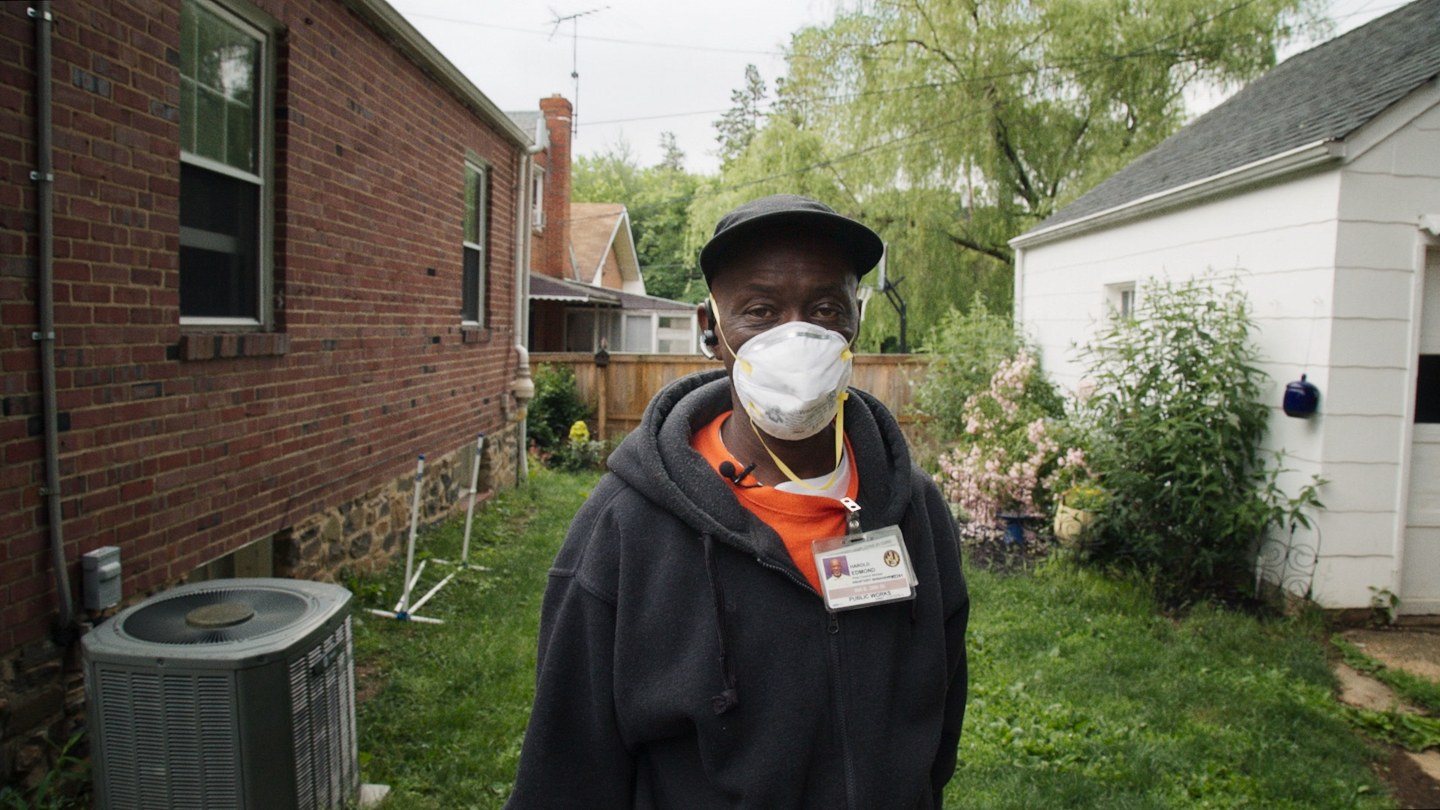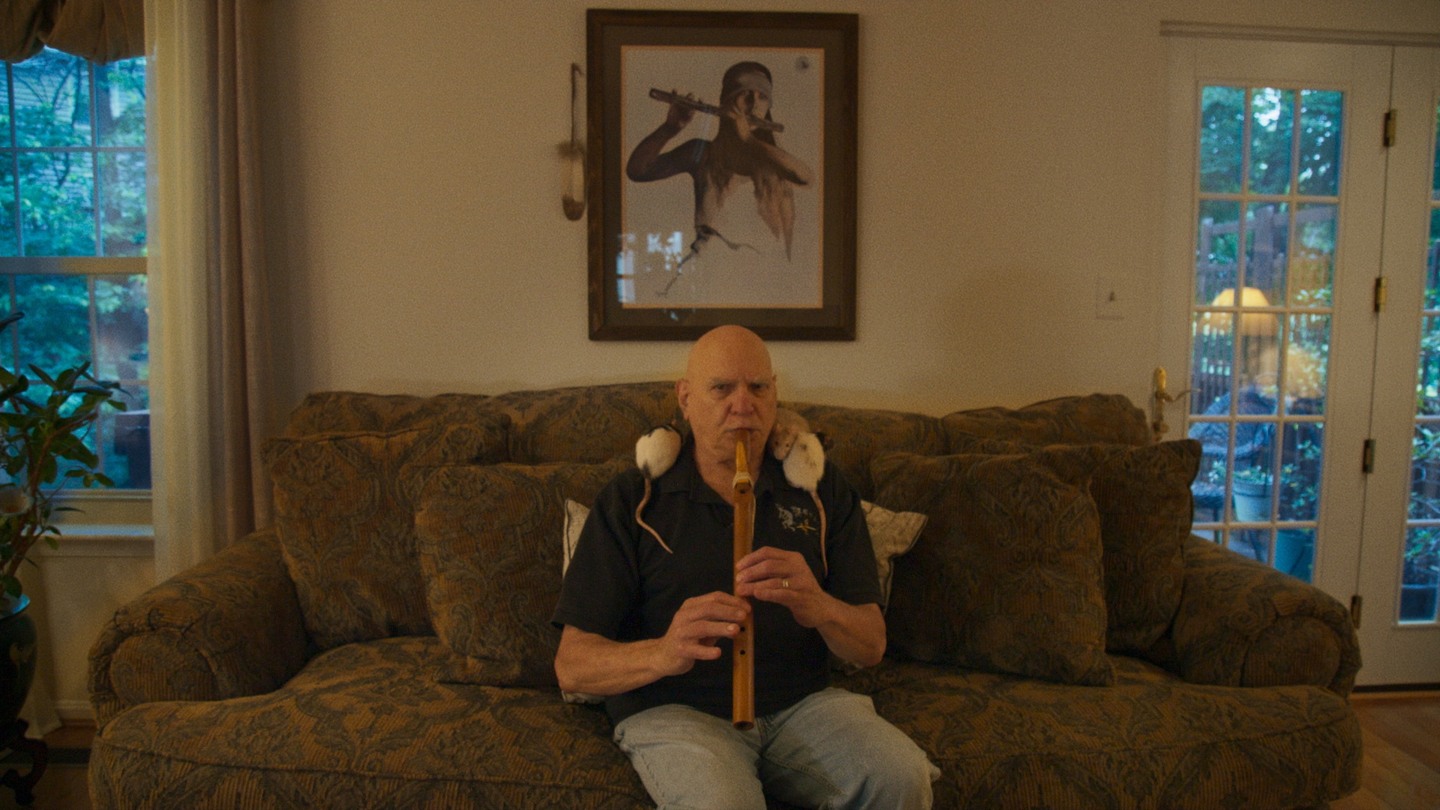 Harold Edmond in Theo Anthony's Rat Film
Photo by MEMORY
Harold Edmond in Theo Anthony's Rat Film
Photo by MEMORY
My viewing of Rat Film, an experimental feature documentary from Baltimore-based filmmaker Theo Anthony, was my most memorable cinema experience of the year. The film, using the rat infestation of Baltimore as a backdrop, paints with the intricacies of structural racism, and reveals how humans — including the viewers — adapt to its effects. It was the reactions of the other attendees in the cinema, predominantly white, upper middle class Toronto residents, that gave my screening a new dimension. Were they laughing with that guy on screen who used beer cans to show how big the rats could get, or was that scoffing I heard? And why did footage of a snake eating a baby rat elicit a more visceral reaction than the film’s explicit outlining of the effects of white supremacy?
Many documentaries exist to emptily affirm the sensibilities of an ostensibly liberal audience, and that often can come at the expense of the subject’s humanity. Rat Film does not fall into this trap. Profiles of compelling figures like Harold Edmond, a rat exterminator employed by the city, are shot with an intrigued empathy. This fantastical embedded reportage a la Werner Herzog (whose “Rogue Film School” Anthony attended) is intercut with the city’s history of premeditated oppression of black communities.
Archival photographs, long forgotten histories, and maps showcasing how “redlining” deprived black communities of loans and investment, are exhumed as proof. These sections are blood-boiling, and voiced by a female narrator whose dispassionate cadence reflects the all-too-prevalent interior monologue encouraging us to dismiss the idea that history has any bearing on the present. The real illusions, Rat Film posits, are far more insidious: one sequence, fragmented throughout the film, transforms Baltimore neighborhoods into poorly rendered Google Street View blocks as a pitch for a "video game." The blurred faces of Baltimore residents and uncanny valley-feeling of their neighborhoods challenge the white liberal viewer’s own flattened perceptions of the oppression occurring down the street. A brilliant soundtrack from Dan Deacon ties the images together, for the most eerily humanizing score since Mica Levi’s work for the Under The Skin OST.
Anthony is white, 28, and grew up thirty minutes outside of Baltimore in Annapolis. “I try to really say [with the film], ‘This isn't the history of Baltimore. This is a history of someone discovering the history of Baltimore,’" he tells me over the phone. His professional resume counts acclaimed short documentaries filmed around the world, but Anthony is now more aware of limitations, and so is Rat Film: Its chaotic, impressionistic structure (though distinctly cinematic, a style established by Chris Marker) elevates the movie with a feeling of self-reflexivity. The combination of history, community, and theory crystallizes the experience of the beginnings of a political awakening, something that can happen many times a day if you’re on Twitter enough. More tangibly, the film encourages the viewer to be curious about where they live, and to reject the politics of pragmatism in the search for a more just world.
The FADER spoke with Theo Anthony about the beginnings of the film, its reception, and the moral and cinematic decisions that go into making a documentary.
You mentioned at the screening on Friday that the Freddie Gray protests were a turning point for your relationship to Baltimore.
THEO ANTHONY: Yeah. I've done a fair amount of work as a journalist, traveling, documenting news and events that are part of a community that I'm very distant from. I have grown used to going to a place and being expected to represent that place as a part of my job.
Then all of a sudden, the Freddie Gray protests broke out and everyone was traveling to my hometown and representing it. It was this total circus of media and spectacle. But it was also this place of hope that something was actually going to change. You had people hanging out across neighborhoods, going into new places and meeting new people.
It actually made me realize that I had this very narrow view of my own backyard. So I just started to really try to learn as much as I could about it.
How did Rat Film change over the course of production?
When I started I really wanted to do a film that was just portraits of people who killed rats. I was watching a lot of Ulrich Seidl films. Then I started to dive into the history of rodent control and urban planning in Baltimore. I realized there was something much, much larger there than just this very limited portrait of people who kill rats. I think that that would have been aesthetically interesting, but incredibly ethically problematic.
Through that, realizing that there was a deeper history to the images that I was making in this film, I think I realized there's a much deeper history to making films, if that makes sense. I think that any time you bring a camera into an environment, there's an inherently staged element. I think that we need to really draw attention to the performative nature of documentary, performative nature of reality. The role of me going out and expecting to extract a very particular thing for a world, and package it into this very particular thing for a very particular audience, is this really colonizing approach to documentary that I realized I was partaking in.
I have been that person in the past without even realizing it. I think a lot of documentary filmmakers unknowingly contribute to that history without even knowing it. They think, Hey. I have a positive message. I'm highlighting “marginalized” stories. So I must be on the right side of history.
You shot, directed, and edited the film yourself. Were you ever tempted to bring on a black Baltimore resident to ensure that the message of the film wasn't retrograde like the films we're talking about here?
I think this film would have been different if there were more people involved. I think the film is what it is and it took the shape that it does because it was mostly me working through this stuff. Going forward, where I do have more resources and I do have a bigger crew, that's an absolute priority for me to integrate more voice in the making of the film so these voices get baked into the film.
The finished film doesn’t present itself as a historical document as much as encourage the viewers to seek out the seams and fissures of their own cities.
That's amazing to hear. When I was making the film, I had this huge anxiety that I was making this hyper-specific tale about Baltimore that wouldn't make any sense to anyone outside of the city.
If there is an impulse of taking away from the film to try to go into your own backyard and understand it, that's awesome. I think it's, sadly, a very familiar tale, that these very subjective points and agendas of the powerful are passed off as objective and inflicted on the people. That's something everywhere, not just Baltimore.
I built this [from] my interest in a lot of different things. I realized that all of these things that I was interested in were connected in this very mysterious way. I documented not just that mystery, but the process of me exploring that mystery. It's a deeply personal film, it's a documentation of me learning.
I'm not going to go discover the history of Baltimore. I'm this privileged white dude learning a lot about black history in Baltimore and taking some poetic license with that history. That's not something to be brushed aside. Those are the core questions I think makes the documentary interesting, but also effective at provoking uncomfortable conversation.
 Louis Eagle Warrior in Theo Anthony’s Rat Film.
Photo by MEMORY
Louis Eagle Warrior in Theo Anthony’s Rat Film.
Photo by MEMORY
Have you had any reactions at screenings from either black or white members of the audience that have made you feel uncomfortable or reassess the film in any way?
I think that there has been a lot of predominantly white audiences where I felt uncomfortable at the amount of laughter. I think it's a really funny movie, and it's totally okay to laugh, as long as you're thinking about what you're laughing about and why. I've had a lot of people who have seen it multiple times, who say, "The first time I was really laughing. The second time it made me super uncomfortable with the laughter."
Other reactions have been really emotional. Like, "I'm a from a neighborhood that you sort of write off in your film. It doesn't look like that. There's doctors there. There's lawyers there. My family lives there. There's more than a rat infested neighborhood." I think that's really important to listen to.
I think the film asks you to very deliberately play with a lot of association between humans and rats. I really don’t think that this film makes the equivalency that humans are rats and rats are humans. It's really important to say the opposite. Humans are not rats and rats are not humans. But I'm asking people to bring in their own biases. Their own experience. Their own experience with negative stereotypes and history that have been perpetrated against them, or they have been perpetrated by them.
Has Harold seen the film?
Yeah. I did a private screening for [Harold’s company] Rat Rubout and their managerial office, which is the Department of Public Works in Baltimore. We had a screening of like 30 or 40 people. It was not only the Rat Rubout team and their bosses, but their bosses' bosses, and the bosses' bosses' bosses.
Everyone was really nervous. Harold hadn't seen it yet. He came up to me before the film. He goes, "Really good to see you, but I really hope you didn't throw me under the bus." He was in front of his bosses, you know? I thought that I had tried to handle it with respect but I don't know how these men think. Everyone was grumbling at each other, back and forth, about overtime pay. Then the film started, and everyone just started laughing, and engaging with the film. When Harold came on, everyone was cheering for him.
After the film ended, I got up to thank everyone. The room was totally segregated. On the left-hand side was all the managerial people, the managers, the head of all the departments. And on the right-hand side were the people who work in the streets of Baltimore.
They turned towards each other, and they just started talking. They ignored me. The whole screening turned into this impromptu town hall. They were voicing their discontent with certain programs. That was a moment where you're like, "Wow." That's the coolest thing a film can do, I think. To have this thing that I made to be this surface that can catalyze connection, that was really, really amazing. This whole film has been a lesson in politics and compromise. I can't say how much has actually come out of those discussions, which is another lesson in itself. But for a fleeting moment, there was this glimmer of possibility and change.